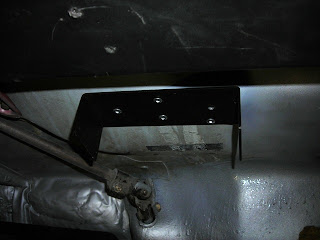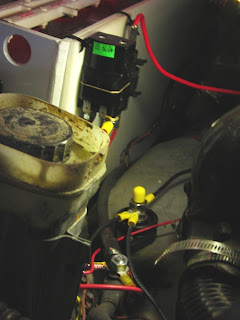This is a summary of the process of converting a Porsche 914 from gas to electric. There is much more info in the other posts on this blog, as well as in the links to the right, so, feel free to explore. In the meantime, here's the story...
It started in September of 2005 when I purchased this 1975 Porsche 914 in Colorado Springs and drove it home to Fort Collins:

I ordered the kit from
Electro Automotive, and once enough parts showed up, I started the disassembly process. The very first thing was removing the internal combustion engine. Here is the engine bay without the engine. Note the rusty area in the lower center of the picture:

Here is a closer look at the rusty spot. This is called the "Hell Hole" in
Porsche 914 restoration circles. The discovery of this rust-through prompted a year-long journey into complete restoration:

I stripped the entire car down to bare metal, using a combination of citrus-based chemical strippers, an orbital sander, a wire brush on an angle grinder, and sandblasting:

I repaired the rust holes (several more than just the one shown above) and primed the car with metal-etching primer:

I painted the interior silver to match what the exterior would be. Here is the repaired hell-hole:

I then sent the car out to a professional for final paint. Here it is, back from paint and after I had installed most of the components, trim, and accessories:

The restoration complete (Fourth of July weekend 2007), it was time to complete the conversion. The kit comes in many, many pieces. Here are most of them, including the controller and motor:

The battery boxes are made out of acid-resistant plastic (polypropylene), and fit into custom-built racks and tiedowns:

The motor fits into the spot where the original motor was. It mounts to the original manual transmission. Here is a picture of the motor - it is not normally this visible, since the engine bay gets filled with 9 of the 18 batteries:

There is a fair amount of wiring to do with the kit. Here is the wiring that goes into the engine bay:

And here is the wiring that goes into the front compartment, mounted on the front battery box:

The controller sits in the rear trunk. It takes the 144 volt DC in (the two black cables going from left to right), and converts it to 3-phase AC (the really thick black cable coming from the middle). The AC drives the motor. There are a variety of other signals that go into the controller, including a motor speed sensor, throttle controls, keyswitch signals, etc.

Six of the 8-volt batteries are located in the battery box in the front compartment:

Three of the batteries are in the middle battery box, where the gas tank used to be:

And the other nine batteries are in the engine bay. This picture also shows the copper strap interconnects between the batteries. Straps are much more resistant to failure from flexing than cables:

Here is the front compartment with the boxes all closed up. The black box in the middle is the charger. You can see the charging cable plugged into the bumper at the lower right. Although you can get a 110-volt AC charger, I decided to go with 240-volt - it cuts the charging time in half (down to about 5 hours for a complete recharge). Also visible are the silver vent hoses - while charging, fans run to pull hydrogen gas out of the car so a spark does not start an explosion.

Here is a closeup of the charger plug on the front bumper:

When plugged in, the red light in the upper left of the gauge cluster is lit. And, when the charger is active, the red light on the right side of the gauge cluster lights up:

When the charge is complete, the red light on the right turns off, and the green light on the right comes on. The red light on the left is still lit, since it's still plugged in. There are interlocks that prevent the car from operating when it is plugged in, but it's still handy to have a reminder on the dash:

When you unplug the car and turn the key on, it looks pretty much just like a normal car. The green light on the lower left indicates that the 12-volt system is active. Instead of a gas gauge, there are three electric gauges - an ammeter (lower left), a high-voltage meter (top), and a 12-volt voltmeter (lower). Monitoring these gauges helps to understand the performance of the vehicle:

And that's pretty much it. The restoration took a year - from July 2006 to July 2007. The conversion itself took four months. Driving is very similar to driving a gas-operated vehicle - you still use the clutch to shift gears - but there are also differences. The biggest difference is the noise - it sounds very much like a Jetsons car! Another difference is that you do NOT push the clutch in while decelerating - because you need the wheels to turn the motor for regenerative braking. The 18 8-volt batteries (US Battery 8VGC) provide lots of energy, but they are very heavy (about 1200 pounds). The car weighs about 2900 pounds net now. In a couple of years, when it is time to replace the batteries, I hope there is some new technology available that can provide the 144 volts at substantially lower weight.
There are lots of people to thank - from
TimK who was the first to assemble this kit, to the very supportive people at
Azure Dynamics (the manufacturers of the motor and controller), to the staff at
Pelican Parts and the community at
914world. And, most importantly - my family, who were very very supportive during this entire process.
In the next week or so, I plan on making a video with a lot of this info on it. In the meantime, if you have any questions, feel free to add them to the comment section and I'll respond.











































